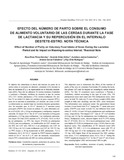Efecto del número de parto sobre el consumo de alimento voluntario de las cerdas durante la fase de lactancia y su repercusión en el intervalo destete-estro. Nota técnica

View/
Date
2015-04Author
Palabras Clave
Condicion corporal, Estructura de partos, Fase de lactancia y reproduccionBody condition, Structure of parity, Lactation period and reproduction
Metadata
Show full item recordAbstract
El objetivo fue determinar el efecto del número de parto de la
cerda sobre el consumo de alimento voluntario (CA) durante la
fase de lactancia (FL) y su repercusión en el intervalo desteteestro
(IDE). Para ello se utilizaron 18 cerdas mestizas (Yorkshire
x Landrace x Pietrain), divididas de acuerdo al tipo de cerdas
(TC): TC1 cerdas primíparas y TC2 cerdas multíparas. En ambos
TC se midió CA diario (d), pérdida de peso corporal (PPC),
peso de la camada al nacimiento y al destete; así como el IDE.
La información se analizó bajo los modelos lineales generalizados.
Se encontró que, el CA d–1 durante la 1ª semana (sem)
post-parto (PSPP) fue menor en ambos TC, pero diferentes entre
sí (P<0,05): 2,6 y 3,8 kg en primíparas y multíparas, respectivamente.
El mayor CA d-1 fue al 15vo d de lactación (3,6 kg para
primíparas y 4,0 kg para multíparas). Las multíparas presentaron
mayor CA total (CAT) durante la FL (P<0,05): 103,4 vs 82,4
kg en primíparas. La PPC fue mayor (P<0,05) en primíparas
(12,9%) que en multíparas. La clasificación de CAT mostró menor
IDE con CAT alto: IDE=4,3 d en primíparas con CAT de
105-119 kg y de 3,0 d para multíparas con CAT de 120-131 kg.
La PPC mayor a 20 kg incrementó el IDE: primíparas, 7,0 d;
multíparas, 6,6 d. El CA d–1 durante la PSPP impacta negativamente
al CA d–1 en la 2ª y 3er sem de lactancia, ocasionando
mayor PPC e incremento del IDE en cerdas primíparas.
Collections
Información Adicional
| Otros Títulos | Effect of number of parity on voluntary food intake of sows during the lactation period and its impact on weaning-to-estrus interval. Thecnical note |
| Correo Electrónico | rosa_elenap@yahoo.com aurelianojuarez@hotmail.com |
| ISSN | 0798-2259 |
| Resumen en otro Idioma | The objective was to determine the effect of the number of parity of the sow on voluntary food intake (FI) during the lactation phase (LP) and its impact on weaning-to estrus interval (WEI). For this 18 crossbred sows (Landrace x Pietrain x Yorkshire), divided according to the type of sows (TS): TSI primiparous sows were used and TS2 multiparous sows, were used. In both TS, daily (d), FI, loss of body weight (LBW), litter weight at birth and weaning; and the WEI, were measured. The information was analyzed under the generalized linear models. It was found that FI d–1 during the 1st week (wk) postparity (FWPP) was lower in both TS, but different from each other (P <0.05): 2.6 and 3.8 kg in primiparous and multiparous sows, respectively. The largest CA d-1 was at 15th d of lactation (3.6 kg and 4.0 kg for primiparous and multiparous, respectively). Multiparous sows, showed higher total FI (TFI) during the LF (P<0.05): 82.4 vs 103.4 kg in primiparous sows. LBW was higher (P<0.05) in primiparous sows (12.9%) than in multiparous sows. The classification of TFI showed lower WEI with high TFI: WEI = 4.3 d in primiparous sows with TFI of 105-119 kg and 3.0 d for multiparous sows with TFI of 120- 131 kg. LBW higher than 20 kg increased the WEI: primiparous sows, 7.0 d; multiparous sows, 6.6 d. CA d–1 during the FWPP negatively impacts FI d–1 in the 2nd and 3rd wk of lactation, causing higher LBW and increased WEI in gilts. |
| Colación | 145-152 |
| País | Venezuela |
| Institución | Universidad del Zulia (LUZ) Universidad de Los Andes (ULA) |
| Publicación Electrónica | Revista Científica |
| Sección | Revista Científica:Producción Animal / Animal Production |





